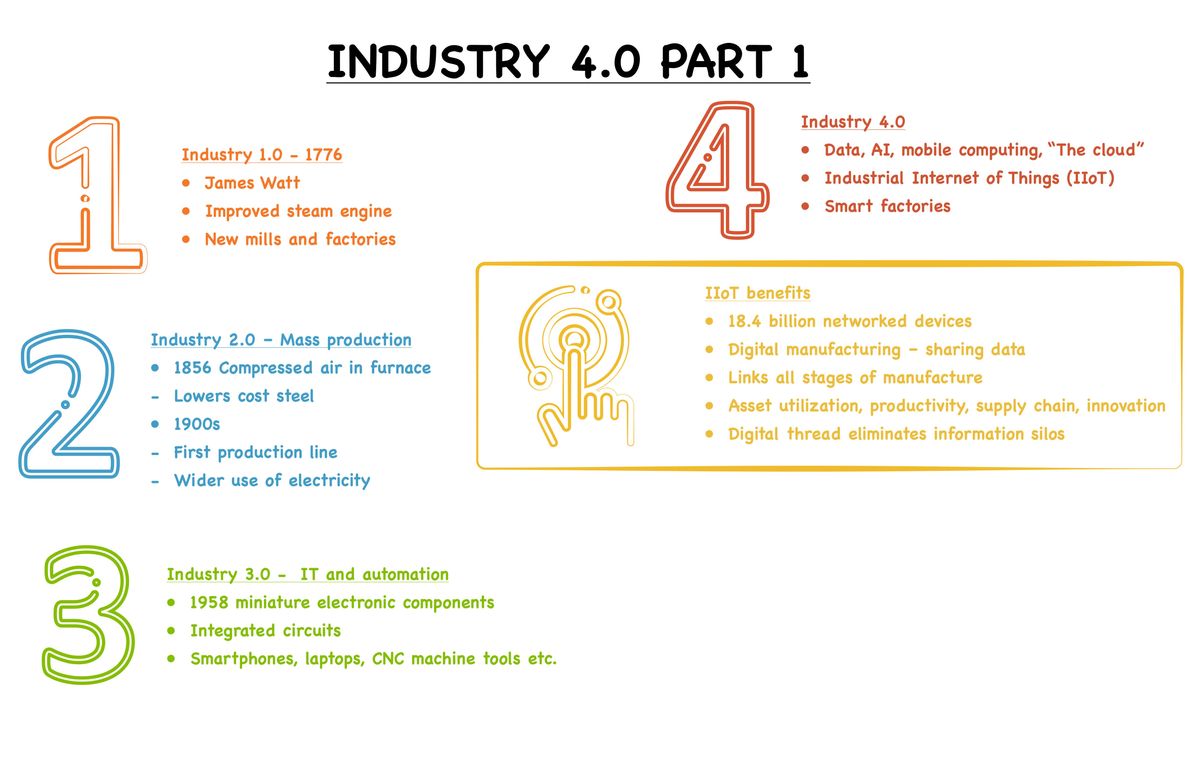
Industry 4.0 Part 1
Your masterclass in product design and development
Protolabs’ Insight video series
Our Insight video series will help you master digital manufacturing.
Every Friday we’ll post a new video – each one giving you a deeper Insight into how to design better parts. We’ll cover specific topics such as choosing the right 3D printing material, optimising your design for CNC machining, surface finishes for moulded parts, and much more besides.
So join us and don’t miss out.
Insight: Industry 4.0 Part 1
Transcript
Hello. It’s Friday, which means it’s time for another Insight video.
This week, and next week, we’re going to look at industry 4.0. First, we’ll take a bit of a history lesson before examining what Industry 4.0 means and next week we’ll explore how some companies have embraced change and what the smart factory of today and tomorrow should look like.
So, if we are now at Industry 4.0, what exactly were Industry 1, 2 and 3?

Let’s go right back in time to 1776. A young Glaswegian engineer called James Watt had to repair a steam engine. In the true spirit of engineering he realised that he could improve the design to increase its thermal efficiency. And it was this improved version that became widely used in the new mills and factories that began springing up. The first industrial revolution had begun.

Industry 2.0 was all about mass production. Moving forwards to 1856, Sir Henry Bessemer managed to lower the cost of steel production by introducing compressed air into a furnace filled with molten pig iron. Fast forward to the 1900s and Henry Ford introduced the first production line. This and the wider use of electricity began to shape what we might begin to recognise as a manufacturing plant.

What’s next? Well Industry 3.0 is all about IT and automation. In 1958 Jack Kilby worked through his company’s summer shutdown to miniaturise electronic components. His work would lead to integrated circuits. Without Jack we would not have smartphones, laptops, CNC machine tools or the software systems that manage today’s manufacturing plants.

And now the pace of change is really accelerating with industry 4.0. The term was first used in 2007, when a German economist called Klaus Schwab concluded that the world was entering a fourth industrial revolution.
He was talking about a digital shake up that would revolutionise manufacturing with low cost data storage, artificial intelligence, mobile computing, cloud-based computer systems and much more Essentially it means that machines, devices, and software could now think independently.
Anyway, in 2013, a German working group on industry 4.0 talked about how factories should use direct networking of smart devices via the internet. We now call this the industrial internet of things and another acronym was born – the IIoT.
The Internet of Things is now part of our everyday lives. Wearable fitness trackers, self-learning thermostats and even self-driving cars are some of the smart devices using this technology to make our lives simpler.
On a larger scale, governments can track pollution levels, check for water contamination, warn the public about earthquakes or fire, monitor infrastructure such as bridges and roads and improve the efficiency of electricity grids. And that’s only really scratching the surface of what’s possible.
But what about the industrial internet of things? Well the potential is staggering. Even back in 2013 CISCO predicted an additional 11.4 trillion pounds of value from the IIoT for private sector companies by 2022. It will improve asset utilisation, employee productivity, our supply chain and logistics, customer experience and innovation.
And some of the figures are truly staggering. According to Cisco there was an estimated 18.4 billion networked devices in 2018 and there will be 29.3 billion by 2023; that’s more than three for every person in the world. Clearly connectivity is the future for us both personally and in the workplace.
 For us in manufacturing, Industry 4.0 is far more than smart gadgets and machine tools though. Digital manufacturing is a new way of sharing data through a product’s entire life cycle. Integrated software platforms link all areas of manufacturing from initial product design, managing factory layout, production and the supply chain, right through to customer feedback after delivery.
For us in manufacturing, Industry 4.0 is far more than smart gadgets and machine tools though. Digital manufacturing is a new way of sharing data through a product’s entire life cycle. Integrated software platforms link all areas of manufacturing from initial product design, managing factory layout, production and the supply chain, right through to customer feedback after delivery.
It’s a digital thread that eliminates silos of information to tie together every aspect of manufacturing. It’s a perfect loop of information that links product conception, design, prototyping and manufacturing and then redesign and improvement. All of this is managed by that big brother of acronyms ERP or enterprise resource planning.
Okay there’s the history lesson and some of the latest thinking. But we engineers are practical people, so next week I’m going to get down to the nuts and bolts and explore how different companies use this digital revolution to develop new manufacturing techniques.
It’s certainly a time of change right now and we need to embrace it. Industry 1, 2 and 3 may have taken a couple of centuries, but Industry 4.0 will move far faster. The question is are we all ready to keep up?
Goodbye for now and I hope to see you next Friday.
With special thanks to Natalie Constable.







